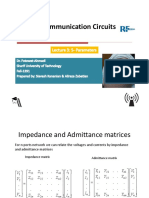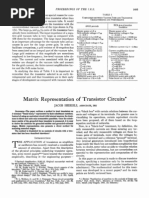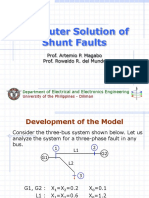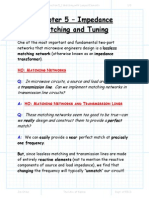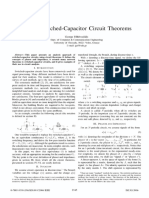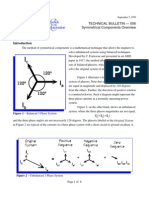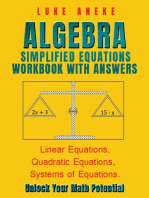Example Using The Impedance Matrix
Uploaded by
Kalai SelvanExample Using The Impedance Matrix
Uploaded by
Kalai Selvan9/4/2007 Example Using the Impedance Matrix 1/3
Jim Stiles The Univ. of Kansas Dept. of EECS
Example: Using the
Impedance Matrix
Consider the following circuit:
Where the 3-port device is characterized by the impedance
matrix:
2 1 2
1 1 4
2 4 1
=
Z
Lets now determine all port voltages
1 2 3
V ,V ,V and all currents
1 2 3
I , I , I .
1
I
3
I
2
V
+
1
V
+
3
V +
2
I
Z
+
-
1
16
1
9/4/2007 Example Using the Impedance Matrix 2/3
Jim Stiles The Univ. of Kansas Dept. of EECS
A: We dont need to know whats inside that box! We know
its impedance matrix, and that completely characterizes the
device (or, at least, characterizes it at one frequency).
Thus, we have enough information to solve this problem. From
the impedance matrix we know:
1 1 2 3
2 1 2 3
3 1 2 3
2 2
4
2 4
V I I I
V I I I
V I I I
= + +
= + +
= + +
A: True! The impedance matrix describes the device in the
box, but it does not describe the devices attached to it. We
require more equations to describe them.
Q: How can we do thatwe
dont know what the device
is made of! Whats inside
that box?
Q: Wait! There are
only 3 equations
here, yet there are
6 unknowns!?
9/4/2007 Example Using the Impedance Matrix 3/3
Jim Stiles The Univ. of Kansas Dept. of EECS
1. The source at port 1 is described by the equation:
( )
1 1
16 0 1 V . I =
2. The short circuit on port 2 means that:
2
0 V =
3. While the load on port 3 leads to:
( )
3 3
1 V I = (note the minus sign!)
Now we have 6 equations and 6 unknowns! Combining equations,
we find:
1 1 1 2 3
1 2 3
16 2 2
16 3 2
V I I I I
I I I
= = + +
= + +
2 1 2 3
1 2 3
0 4
0 4
V I I I
I I I
= = + +
= + +
3 3 1 2 3
1 2 3
2 4
0 2 4 2
V I I I I
I I I
= = + +
= + +
Solving, we find (Ill let you do the algebraic details!):
1
7 0 I . =
2
3 0 I . =
3
1 0 I . =
1
9 0 V . =
2
0 0 V . =
3
1 0 V . =
You might also like
- Section 2E Microwave Network Theory PackageNo ratings yetSection 2E Microwave Network Theory Package42 pages
- Section 4 2 Impedance and Admittance Matricies PackageNo ratings yetSection 4 2 Impedance and Admittance Matricies Package25 pages
- Electromagnetic Diagnostics Lab. Dit Università Di Trento Dit - Università Di Trento Via Sommarive 14, I-38050 Trento Italia E-Mail: Massmo E Mail: MassmoNo ratings yetElectromagnetic Diagnostics Lab. Dit Università Di Trento Dit - Università Di Trento Via Sommarive 14, I-38050 Trento Italia E-Mail: Massmo E Mail: Massmo41 pages
- Writing Mesh & Nodal Equations Directly Matrix FormNo ratings yetWriting Mesh & Nodal Equations Directly Matrix Form17 pages
- Matrix Representation of Transistor CIrcuitsNo ratings yetMatrix Representation of Transistor CIrcuits5 pages
- EE251 Note 10 - Computer Solution of Shunt FaultsNo ratings yetEE251 Note 10 - Computer Solution of Shunt Faults66 pages
- Steps To Solve Power Flow Analysis For DummiesNo ratings yetSteps To Solve Power Flow Analysis For Dummies6 pages
- Steps To Solve Power Flow Analysis: For Dummies: ExampleNo ratings yetSteps To Solve Power Flow Analysis: For Dummies: Example6 pages
- Power Systems (Summarized) Imp. formulasNo ratings yetPower Systems (Summarized) Imp. formulas17 pages
- PMU Lecture 6 - The Impedance Model and ZbusNo ratings yetPMU Lecture 6 - The Impedance Model and Zbus17 pages
- Section 5 1 Matching With Lumped Elements PackageNo ratings yetSection 5 1 Matching With Lumped Elements Package29 pages
- Dokumen - Tips Application of Linear Algebra in Electrical CircuitNo ratings yetDokumen - Tips Application of Linear Algebra in Electrical Circuit19 pages
- Linear Switched-Capacitor Circuit Theorems: Ex (N) X (n+1)No ratings yetLinear Switched-Capacitor Circuit Theorems: Ex (N) X (n+1)4 pages
- Matrix Modeling of A Network: Computation of Bus Impedance and Admittance MatricesNo ratings yetMatrix Modeling of A Network: Computation of Bus Impedance and Admittance Matrices95 pages
- Network Admittance and Impedance Matrices: Admittance Matrix (Also Known As YNo ratings yetNetwork Admittance and Impedance Matrices: Admittance Matrix (Also Known As Y25 pages
- An Example of 3phase Transformer Modeling For Distribution SysteNo ratings yetAn Example of 3phase Transformer Modeling For Distribution Syste5 pages
- An Introduction To Symmetrical Components, System Modeling and Fault CalculationNo ratings yetAn Introduction To Symmetrical Components, System Modeling and Fault Calculation66 pages
- A Brief Introduction to MATLAB: Taken From the Book "MATLAB for Beginners: A Gentle Approach"From EverandA Brief Introduction to MATLAB: Taken From the Book "MATLAB for Beginners: A Gentle Approach"2.5/5 (2)
- Student Solutions Manual to Accompany Economic Dynamics in Discrete Time, secondeditionFrom EverandStudent Solutions Manual to Accompany Economic Dynamics in Discrete Time, secondedition4.5/5 (2)
- ALGEBRA SIMPLIFIED EQUATIONS WORKBOOK WITH ANSWERS: Linear Equations, Quadratic Equations, Systems of EquationsFrom EverandALGEBRA SIMPLIFIED EQUATIONS WORKBOOK WITH ANSWERS: Linear Equations, Quadratic Equations, Systems of EquationsNo ratings yet
- Mathematics 1St First Order Linear Differential Equations 2Nd Second Order Linear Differential Equations Laplace Fourier Bessel MathematicsFrom EverandMathematics 1St First Order Linear Differential Equations 2Nd Second Order Linear Differential Equations Laplace Fourier Bessel MathematicsNo ratings yet
- Simple Grammer: Adjective or Adverb: Fill in The Words in Brackets As Adjective or AdverbNo ratings yetSimple Grammer: Adjective or Adverb: Fill in The Words in Brackets As Adjective or Adverb13 pages
- By Ajal.A.J Assistant Professor Electronics & Communication Engineering DeptNo ratings yetBy Ajal.A.J Assistant Professor Electronics & Communication Engineering Dept95 pages





